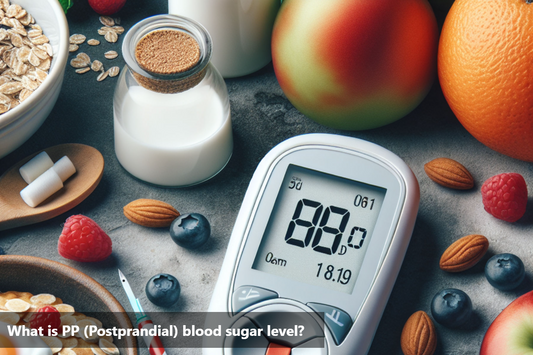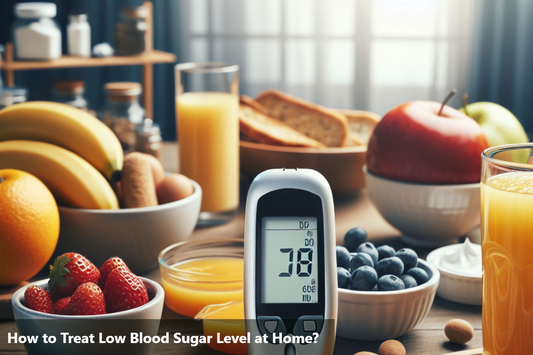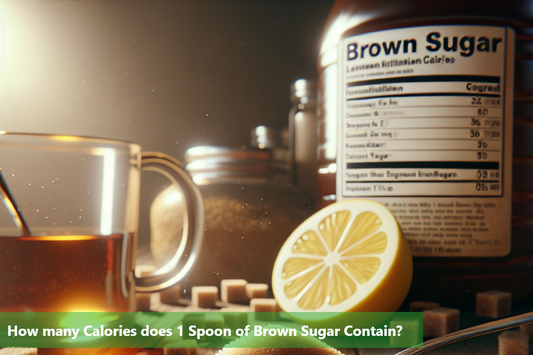Our health depends a lot on having the right amount of sugar, or glucose, in our blood. This glucose gives us energy. It's key to understand how our blood sugar changes when we eat.
Here's why this matters: Our body needs to control spikes in blood sugar after meals to stay healthy. When we eat, our body turns food into glucose, causing our blood sugar to rise. It's crucial for our body to handle this spike to prevent issues like diabetes and support long-term health.
Knowing this helps us see why balancing blood sugar levels matters. It highlights the importance of what happens after we eat. Understanding this can help people make informed choices about diet and lifestyle for better health. Next, let's discuss what's considered a normal blood sugar level after a meal and why it matters.
Understanding Blood Sugar Levels
-
Blood sugar levels, also known as glucose levels, show how much glucose is in the blood. Glucose is the main energy source for our body's cells and is created when we eat, especially foods with lots of carbohydrates. Our body has a system to control these levels and keep them in the right range for good health.
-
The pancreas, an important organ in this system, releases insulin when blood sugar levels go up. Insulin acts like a key, letting cells take in glucose and lowering blood sugar levels. The liver also helps by storing extra glucose for later use, maintaining the balance.
Understanding how food affects blood sugar and how the body handles it is important. It helps people make smart choices about what they eat, keeping their blood sugar stable and lowering the chances of health problems. Now, let's look at what's considered a normal blood sugar level right after eating.
Normal Blood Sugar Level Immediately After Eating
-
Right after you eat, a normal blood sugar level is usually between 140 to 180 milligrams per deciliter (mg/dL). This can vary a bit depending on different factors, but it's a general guideline. Knowing what's considered normal after eating is important for understanding your metabolic health.
-
Different things affect these levels right after a meal. The type of food you eat matters; meals high in carbohydrates make your blood sugar go up more. However, having fiber, healthy fats, and proteins can help slow down how fast your body absorbs glucose, lessening the spike.
-
Everyone is different, and that affects how your blood sugar behaves after eating. Things like age, weight, how active you are, and your overall health influence how your body handles glucose. People with good insulin sensitivity usually have more steady blood sugar levels after meals compared to those with insulin resistance or diabetes.
-
It's important to pay attention if your blood sugar stays consistently high after eating. Long-term high levels can lead to insulin resistance and increase the risk of getting type 2 diabetes. Keeping an eye on and understanding these immediate post-meal levels helps you make choices that support your health.
In the next part, we'll talk about normal blood sugar levels about two hours after eating, giving more insight into how your body manages glucose over time.
Normal Blood Sugar Level After 2 Hours of Eating
-
About two hours after you eat, it's best if your blood sugar goes back to the normal range, which is usually below 140 milligrams per deciliter (mg/dL). This time frame is important because it shows how well your body manages sugar over time.
-
The two-hour point is crucial because it tells us how good the body is at dealing with and getting rid of sugar from the blood after eating. A healthy response means insulin helps cells take in sugar, bringing levels back to normal. Being able to return to normal levels within two hours is a good sign for how well your metabolism is working.
-
If the body has trouble lowering blood sugar two hours after eating, it might suggest problems with how sensitive the body is to insulin or how it handles sugar. If levels stay high during this time, it could lead to long-term issues like insulin resistance and a higher chance of getting diabetes.
-
Checking blood sugar at the two-hour mark helps understand how the body deals with different foods and how well it regulates sugar. It's a useful measure for people to see how their food choices affect their health. In the next part, we'll look at different things that can affect blood sugar after meals and share practical tips for keeping levels in a good range.
Factors Affecting Post-Meal Blood Sugar Levels
After you eat, the amount of sugar in your blood can be influenced by various things. Understanding these factors can help you make smart choices to keep your blood sugar levels in check.
-
Types of Food: What you eat affects your blood sugar. Foods with lots of sugars and simple carbs can make it go up quickly. On the flip side, eating foods high in fiber, good fats, and lean proteins slows down how your body absorbs sugar. This helps keep your blood sugar levels steady after eating.
-
Portion Sizes: Eating too much, even if it's healthy food, can raise your blood sugar levels after a meal. Keeping an eye on how much you eat is important to avoid having too much sugar in your bloodstream. Controlling portions helps your body handle sugar better.
-
Meal Timing: When you eat matters too. Spreading out your meals evenly during the day helps keep your blood sugar steady. Skipping meals or waiting a long time between them can cause ups and downs in your blood sugar levels.
-
Individual Differences: Your age, weight, and how active you are all play a part in how your blood sugar responds after eating. Understanding these differences lets you personalize your approach to maintaining healthy blood sugar levels.
Tips for Keeping Blood Sugar in Check:
-
Choose whole, unprocessed foods with a mix of carbs, proteins, and fats.
-
Have smaller, more frequent meals to support steady blood sugar levels.
-
Include foods high in fiber, like veggies, fruits, and whole grains, to slow down sugar absorption.
-
Stay hydrated, as water helps with digestion and keeps blood sugar balanced.
By thinking about these factors and making healthy food choices, you can have a positive impact on your blood sugar levels after meals. In the next section, we'll go over the main points and stress why it's important to keep an eye on and manage normal blood sugar levels after eating.
Summary
It's important to understand and keep your blood sugar levels normal after meals for good health. We've talked about why these levels matter, how your body handles glucose, and the right ranges just after eating and two hours later.
Remember, eating balanced meals with fiber and watching portion sizes helps keep your blood sugar stable after eating. Checking your levels two hours after a meal gives useful information about how well your body manages glucose, helping you take charge of your health.
Keeping your blood sugar in check isn't just about preventing diabetes; it's a key part of staying healthy overall. Making smart food choices and considering your unique needs can positively affect your metabolic health.
Everyone's body is different, influenced by things like age, weight, and how active you are. So, it's a good idea to talk to healthcare professionals for personalized advice. They can give guidance tailored to your health conditions and needs.
Taking control of your post-meal blood sugar is a proactive step in your health journey. Stay informed, build healthy habits, and seek advice from professionals to improve your well-being and enjoy a healthier, more balanced life.
DiabeSmart is the first food range exclusively crafted for diabetics. Enjoy clinically tested, delicious products that let you keep your favorite food habits while managing your blood sugar levels effortlessly.
This Blog post is an initiative by DiabeSmart, to provide accurate and Nutritionist / Doctor approved information related to Diabetes. DiabeSmart is India's first Food brand designed specifically for Diabetics, that has been clinically tested on Diabetics and Pre-Diabetics to deliver 55% - 70% lower Sugar spikes. DiabeSmart is part of Lo! Foods - India's leading brand for Everyday Functional Health foods.















